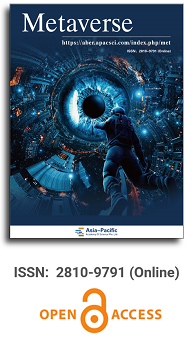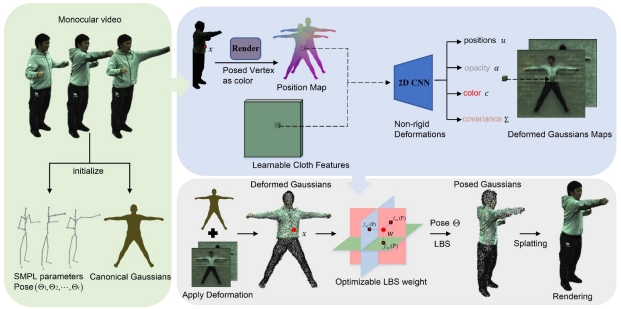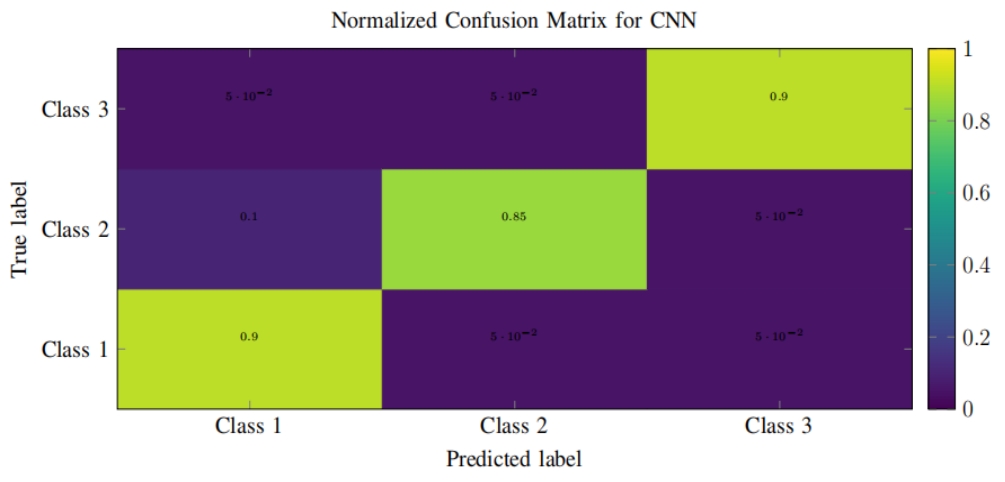
Asia Pacific Academy of Science Pte. Ltd. (APACSCI) specializes in international journal publishing. APACSCI adopts the open access publishing model and provides an important communication bridge for academic groups whose interest fields include engineering, technology, medicine, computer, mathematics, agriculture and forestry, and environment.



Issue release: 31 December, 2024
As we present Volume 5, Issue 2 of Metaverse, we find ourselves at a pivotal juncture where artificial intelligence (AI) and the metaverse intersect, heralding transformative changes across various domains. This edition delves into the multifaceted applications of AI within the metaverse, exploring its potential to revolutionize manufacturing, education, cultural heritage conservation, and beyond. The convergence of AI and the metaverse is not merely a technological phenomenon but a philosophical and cultural shift that reflects humanity’s aspirations for a more interconnected and intelligent future. As Alan Turing, often regarded as the father of AI, stated, “Instead of trying to produce a program to simulate the adult mind, why not rather try to produce one which simulates the child’s?” [1]. This underscores the boundless possibilities of creativity and learning inherent in AI—qualities that now extend into the immersive landscapes of the metaverse.
Issue release: 31 December, 2024
Based on the evolution of immersive technologies, both in software and hardware, this article proposes a methodology for creating accessible and inclusive virtual worlds, with potential impacts on education, training, and lifelong learning. Through this paradigm, the combination of real and virtual cosmos generates new challenges in accessibility and inclusion. The co-existence of virtuality in tangible real life could be extended respectively in a wide spectrum of everyday life for enhanced inclusion and accessibility. New business models and even more accessible services in training and education could be raised through this suggestion. Metaverse, omniverse, and the advancements in extended reality equipment are the main allies in this endeavor. Artificial intelligence and enhanced experiences via advanced immersion could find easily their role in the context of meaningful virtual worlds in lifelong learning. As we are in the dove of the Metaverse era this is a unique opportunity to build accessible and inclusive virtual worlds from the very beginning.
Issue release: 31 December, 2024
This study conducts an empirical exploration of generative Artificial Intelligence (AI) tools across the game development pipeline, from concept art creation to 3D model integration in a game engine. Employing AI generators like Leonardo AI, Scenario AI, Alpha 3D, and Luma AI, the research investigates their application in generating game assets. The process, documented in a diary-like format, ranges from producing concept art using fantasy game prompts to optimizing 3D models in Blender and applying them in Unreal Engine 5. The findings highlight the potential of AI to enhance the conceptualization phase and identify challenges in producing optimized, high-quality 3D models suitable for game development. This study reveals the current limitations and ethical considerations of AI in game design, suggesting that while generative AI tools hold significant promise for transforming game development, their full integration depends on overcoming these hurdles and gaining broader industry acceptance.
Issue release: 31 December, 2024
With the rapid development of deep learning technology, artificial intelligence (AI) has found wide applications in diverse domains such as image classification, text processing, and autonomous driving. However, the increasing prevalence of security issues cannot be ignored. Studies have shown that deep neural network models face security risks due to adversarial sample attacks. These attacks involve adding imperceptible perturbations to deceive the model’s classification results, exposing vulnerabilities in deep learning model applications. While transfer attack methods offer practicality in real-world scenarios, their current performance in black-box attacks is limited. In this study, we propose a method that combines an attention mechanism and a frequency domain transformation to enhance the robustness of adversarial perturbations, thereby improving the performance of transfer attacks in black-box attack scenarios of deep learning models. Specifically, we introduce the CBAM-ResNet50 enhancement model based on attention mechanisms into transfer attacks, enhancing the model’s ability to identify important image regions. By adding perturbations to these attention-concentrated regions, adversary perturbation robustness is improved. Furthermore, we introduce a method for randomly transforming image enhancement in the frequency domain, which increases the diversity and robustness of adversarial perturbation by distributing perturbations across edges and textures. Experimental results demonstrate that our proposed method, considering both human perceptibility and computational cost, achieves a maximum black-box transfer attack success rate of 60.05%, surpassing the 49.65% success rate achieved by the NI-FGSM method across three models. The average success rate of the five methods exceeds an improvement of 6 percentage points in black-box attacks.
Issue release: 31 December, 2024
This paper presents a comprehensive survey on the advancements and applications of haptic technologies, which are methods that facilitate the sense of touch and movement, in virtual reality (VR) during the COVID-19 pandemic. It aims to identify and classify the various domains in which haptic technologies have been utilized or can be adapted to combat the unique challenges posed by the pandemic or public health emergencies in general. Existing reviews and surveys that concentrate on the applications of haptic technologies during the Covid-19 pandemic are often limited to specific domains; this survey strives to identify and consolidate all application domains discussed in the literature, including healthcare, medical training, education, social communication, and fashion and retail. Original research and review articles were collected from the Web of Science Core Collection as the main source, using a combination of keywords (like ‘haptic’, ‘haptics’, ‘touch interface’, ‘tactile’, ‘virtual reality’, ‘augmented reality’, ‘Covid-19’, and ‘pandemic’) and Boolean operators to refine the search and yield relevant results. The paper reviews various haptic devices and systems and discusses the technological advancements that have been made to offer more realistic and immersive VR experiences. It also addresses challenges in haptic technology in VR, including fidelity, ethical, and privacy considerations, and cost and accessibility issues.
Issue release: 31 November, 2024
In this groundbreaking study, we present a novel approach to interspecies communication, focusing on the understanding of chicken vocalizations. Leveraging advanced mathematical models in artificial intelligence (AI) and machine learning, we have developed a system capable of interpreting various emotional states in chickens, including hunger, fear, anger, contentment, excitement, and distress. Our methodology employs a cutting-edge AI technique we call Deep Emotional Analysis Learning (DEAL), a highly mathematical and innovative approach that allows for the nuanced understanding of emotional states through auditory data. DEAL is rooted in complex mathematical algorithms, enabling the system to learn and adapt to new vocal patterns over time. We conducted our study with a sample of 80 chickens, meticulously recording and analyzing their vocalizations under various conditions. To ensure the accuracy of our system’s interpretations, we collaborated with a team of eight animal psychologists and veterinary surgeons, who provided expert insights into the emotional states of the chickens. Our system demonstrated an impressive accuracy rate of close to 80%, marking a significant advancement in the field of animal communication. This research not only opens up new avenues for understanding and improving animal welfare but also sets a precedent for further studies in AI-driven interspecies communication. The novelty of our approach lies in its application of sophisticated AI techniques to a largely unexplored area of study. By bridging the gap between human and animal communication, we believe our research will pave the way for more empathetic and effective interactions with the animal kingdom.
Issue release: 31 December, 2024
In this paper, we propose a framework for hand tracking in human-computer interaction applications. Leap Motion is used today as a popular interface in virtual reality and computer games. In this study, we evaluated the merits and drawbacks of this device. The limitations of this device restrict the user’s free movement. The purpose of this study is to find an optimal solution for using Leap Motion. We propose a framework to estimate the pose of the hand in a bigger space around Leap Motion. Our framework uses an integration of Leap Motion with a camera that are placed in two different places to capture the information of the hand from various views. The experiments are designed based on the common tasks in the human-computer interaction applications. The finding of this study demonstrates that the proposed framework increases the precise interaction space.
Issue release: 31 December, 2024
As a result of the growing significance and application of technology across a wide range of fields, digital environments such as Metaverse started to take shape over the span of the previous decade. This study aims to discover an area of engineering that could benefit from this new technology by developing an artificial intelligence (AI)—based approach to analyzing and predicting the mechanical properties of carbon fiber reinforced syntactic thermoset composites that are made through additive manufacturing (AM). These composites are intended to be utilized as a tool for metaverse technology in a variety of domains—as the presence of the limitations in the currently experimental methods. The metaverse allows for the generation of simulations through the application of artificial intelligence (AI) and machine learning (ML). Consequently, this paves the way for individuals to investigate various design possibilities and view the virtual manifestation of those possibilities. This is made possible by the use of machine learning algorithms, which allow for the monitoring and evaluation of user performance, as well as the provision of individualized feedback and suggestions for improvement. As a consequence of this, it is feasible that professionals will be able to get education and training that are both more efficient and effective. Consequently, this work aims to introduce an Adaptive Neuro-Fuzzy Inference System (ANFIS)—based model, which is able to effectively anticipate the behavior of mechanical systems in a variety of settings without the need for significant measurements. The validity of the ANFIS model was determined through the utilization of flexure and compression testing. The approach that was used to improve the technical assessment of the manufactured composites—is verified by the model’s near-realistic predictions. Moreover, this method is superb for lowering weight, enhancing mechanical qualities, and minimizing product complexity.
Issue release: 31 December, 2024
The widespread adoption of generative artificial intelligence (GAI) technologies heralds an era of expanding possibilities in the domain of cultural heritage conservation. This paradigm shift is marked by a confluence of innovative methodologies, including digital twin mapping, digital archiving, and enhanced preservation strategies, aimed at safeguarding the vestiges of our shared past. The application of AI within this field represents a frontier where technology and tradition intersect, offering new vistas for the preservation of historical structures and artifacts that are at risk of deterioration or oblivion. This article endeavors to elucidate the perspectives of professionals within the conservation domain on the integration of AI technologies, drawing upon a comprehensive review of scholarly discourse and the insights derived from a qualitative study. These discussions brought forth rich insights from a spectrum of professionals, each contributing unique perspectives based on their domain expertise and experiences. Participants included conservationists, archaeologists, museum curators, technologists, architects, and restorers, among others, whose collective wisdom paints a multifaceted picture of the challenges and opportunities AI presents in this field.
Issue release: 31 December, 2024
With the development of the new media era, factors such as digitization and entertainment are driving changes in the way traditional culture is disseminated. In comparison to traditional distribution media, online games are more vivid, capable of retaining the characteristics of traditional culture while undergoing a livelier transformation and development, and are disseminated in a manner that is widely appealing to the masses. This study, based on the new media characteristics of online games and combined with the current situation of traditional culture dissemination in China and domestic game cases, analyzes the diverse advantages of online games in cultural dissemination, including form, content, promotional methods, and cross-border linkage. It summarizes a dissemination path system starting from three points: cultural resources, game content, and game audience, in order to contribute to the enhancement of the dissemination value of online games and the promotion of contemporary dissemination of traditional culture.
Issue release: 31 December, 2024
Artificial intelligence (AI) stands as a potent catalyst for revolutionizing manufacturing, promising unprecedented efficiency, agility, and resilience. This research embarks on an investigative journey to dissect the multifaceted landscape of AI in manufacturing, aiming to unravel its current status, intrinsic challenges, and prospective pathways. This research unveils the intricate relationship between AI technologies and manufacturing processes across diverse domains. Examining various domains, including system-level analysis, human-robot collaboration, process monitoring, diagnostics, prognostics, and material-property modeling. The research also reveals AI’s transformative potential in optimizing manufacturing operations, enhancing decision-making, and fostering innovation. By dissecting each domain, the research illuminates how AI empowers manufacturers to adapt to dynamic market demands and technological advancements, ultimately driving sustainable growth and competitiveness. Moreover, it also examines the evolving dynamics of human-robot collaboration within manufacturing settings, recognizing AI’s pivotal role in facilitating seamless communication, shared understanding, and dynamic adaptation between humans and machines. Through an exploration of AI-enabled human-robot collaboration, this research underscores the transformative power of symbiotic relationships in reshaping the future of manufacturing. While highlighting opportunities, it acknowledges the myriad challenges accompanying AI integration in manufacturing, such as data quality issues, interpretability of AI models, and knowledge transfer across domains. By addressing these challenges, the research aims to pave the way for more resilient AI-driven manufacturing systems capable of navigating complex market landscapes and technological disruptions. This research sheds light on AI’s transformative potential in manufacturing, inspiring collaborative efforts and innovative solutions that will propel the industry forward into a new era of possibility and prosperity.
Issue release: 31 December, 2024
In the ever-evolving landscape of cyber threats, the integration of Artificial Intelligence (AI) has become popular into safeguarding digital assets and sensitive information for organisations throughout the world. This evolution of technology has given rise to a proliferation of cyber threats, necessitating robust cybersecurity measures. Traditional approaches to cybersecurity often struggle to keep pace with these rapidly evolving threats. To address this challenge, Generative Artificial Intelligence (Generative AI) has emerged as a transformative sentinel. Generative AI leverages advanced machine learning techniques to autonomously generate data, text, and solutions, and it holds the potential to revolutionize cybersecurity by enhancing threat detection, incident response, and security decision-making processes. We explore here the pivotal role that Generative AI plays in the realm of cybersecurity, delving into its core concepts, applications, and its potential to shape the future of digital security.
Issue release: 31 December, 2024
The metaverse is expanding from a simple technology or service into a platform-centric industrial ecosystem. Initially discussed in the context of infrastructure networks, such as computer communication networks, it has since broadened to include content and services related to virtual reality, such as games and films. Recently, the scope of this expanded ecosystem has further widened, linking various types of content through content-based platforms. In this metaverse market, the content market plays a crucial role. This paper aims to examine the current state of the content market within the metaverse market and explore its future development directions. We will analyze various aspects of the content sector utilizing the metaverse both domestically and internationally, investigating how the use of the metaverse is evolving from mere entertainment to a productive market with applicable business models.
Issue release: 31 December, 2024
Standards are important in facilitating the development of new technologies in the Metaverse scene, and machine readable standards are a new form of standards centered on machine reading, execution, and understanding. Therefore, the study of machine readable standards is of great significance to promote the development of Metaverse technology and disciplines. At present, there is no research on the fusion of machine readable standards and Metaverse home and abroad, and there is no research on the research value, key technologies, difficult challenges and application scenarios of machine readable standards under the perspective of Metaverse. Challenges and potential opportunities for the application of machine readable standards are also discussed. Finally, the application scenarios of machine readable standard in the Metaverse field are proposed, including four scenarios: resource retrieval, knowledge question and answer, personalized knowledge push and virtual digital human.
Issue release: 31 December 2024
The metaverse is rapidly emerging as a transformative force in various industries, including marketing and consumer engagement. In Asia, a region at the forefront of metaverse adoption, companies are leveraging this technology to create immersive experiences and reach new audiences. This study examines the evolution of marketing strategies in the metaverse, focusing on successful applications and challenges faced by brands. Through a comprehensive literature review and case studies from China, India, and Southeast Asia, the paper explores the potential of the metaverse for marketing and e-commerce. It highlights the use of immersive technologies like VR and AR to create engaging experiences, enhance customer engagement, and drive brand loyalty. Additionally, the study addresses the challenges associated with the metaverse, such as technological barriers, data privacy concerns, and ethical considerations. The findings reveal that the metaverse offers significant opportunities for brands to innovate and connect with consumers in new ways. However, successful adoption requires a deep understanding of consumer behavior, technological advancements, and regulatory frameworks. As the metaverse continues to evolve, brands must adapt their strategies to stay ahead in this rapidly changing landscape.

Prof. Zhigeng Pan
Professor, Hangzhou International Innovation Institute (H3I), Beihang University, China

Prof. Jianrong Tan
Academician, Chinese Academy of Engineering, China
Conference Time
December 15-18, 2025
Conference Venue
Hong Kong Convention and Exhibition Center (HKCEC)
...
Metaverse Scientist Forum No.3 was successfully held on April 22, 2025, from 19:00 to 20:30 (Beijing Time)...
We received the Scopus notification on April 19th, confirming that the journal has been successfully indexed by Scopus...
We are pleased to announce that we have updated the requirements for manuscript figures in the submission guidelines. Manuscripts submitted after April 15, 2025 are required to strictly adhere to the change. These updates are aimed at ensuring the highest quality of visual content in our publications and enhancing the overall readability and impact of your research. For more details, please find it in sumissions...


 Open Access
Open Access




.jpg)
.jpg)

